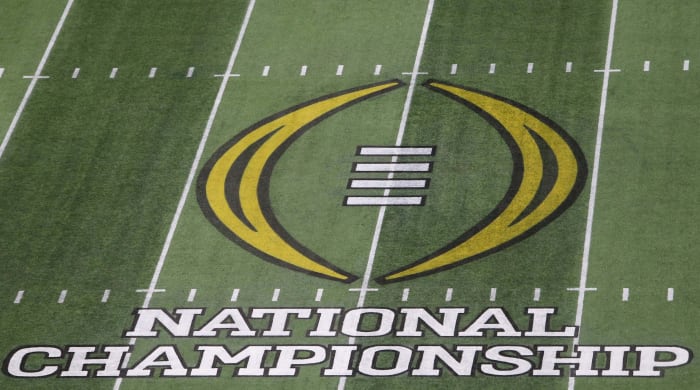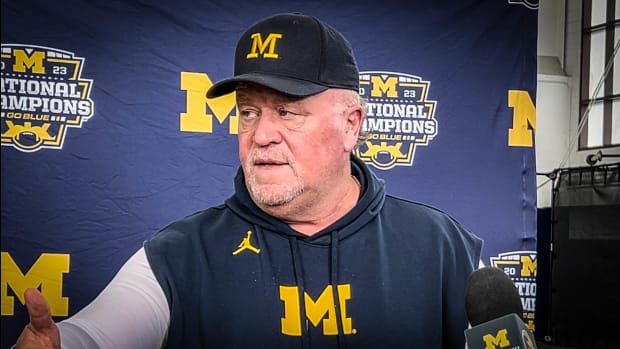Commissioners Mull Alternate 12-Team Playoff Expansion Model
The debate over eight appears over. Now, there’s a new model, as college football leaders are not done haggling over playoff expansion formats just yet.
At their meeting last week, a group of conference commissioners introduced a new alternate 12-team postseason model that guarantees a berth to each Power 5 champion, sources tell Sports Illustrated.
The model is almost identical to the one a subcommittee introduced over the summer—aside from one change. The alternate model grants automatic bids to the Power 5 champions plus the highest-ranked Group of 5 champion. The subcommittee’s proposal gives automatic access to the six highest-ranked conference champions. Each format completes the field with six at-large selections based on rankings.
The CFP Management Committee, the 10 FBS commissioners and Notre Dame athletic director Jack Swarbrick, discussed the alternate proposal—what’s being termed a “5+1” model—last week in Dallas. In the same meeting, commissioners agreed to continue reviewing several other eight-team models, though they are considered a long shot to gain unanimous support.
The alternate proposal is yet the latest wrinkle in a somewhat contentious and frustrating saga that began in June, when a subcommittee of commissioners announced a 12-team proposal that has faced pushback from the Alliance—the Pac-12, Big Ten and ACC. At least two members of the Alliance introduced the alternate 12-team format, multiple athletic administrators tell SI. The Pac-12 is open to any of the three formats, sources say, including either 12-team proposal and an eight-team model.
Commissioners are expected to meet again Dec. 1-2 in Dallas to further explore what appears to be a trio of options: (1) remain at four teams through 2025, the last year of the CFP’s contract with ESPN; (2) approve the subcommittee’s 12-team format; or (3) approve the alternate 12-team model guaranteeing bids to Power 5 champions. Any approved proposal needs the OK from the CFP Board of Managers, a group of school presidents and the ultimate decision-makers in the process.
“It’s 12 or back to four,” one athletic director with knowledge of the discussions told SI.
Leaders are on a deadline. They have about two months to either settle on a new format to be implemented in 2024 or shelve expansion until 2026. The majority of commissioners are in favor of the subcommittee’s 12-team proposal. The model features byes for the four highest-ranked conference champions while the other eight teams play first-round games on the campus of the higher ranked team.
However, the alternate 12-team model, while drawing criticism from some Group of 5 leaders, is viewed as a compromise to recruit the votes of those within the Alliance. In order to expand, CFP executives need unanimous support.
Enough progress was made at last week’s meeting that executives are optimistic about expansion to 12, and some commissioners have even socialized details of the new 5+1 model with their conference athletic directors and presidents.
For instance, in the format, the group has agreed to play first-round games a week later than originally planned. They will kick off two weeks after conference championship games, which are usually played the first full weekend in December.
First-round games are expected to be on the campus of the high seeds, despite some leagues pushing back on that item for weather-related issues. Host schools, especially those located in northern climates, can have the flexibility to move a game to a regionally located indoor stadium of their choice.
The alternate 12-team model is a sticking point for some administrators on the Group of 5 level. Some describe it as “unfair” to their leagues and “inconsistent” with the original mission of the CFP. The model further creates a dividing line between two groups within FBS that are split along revenue-generating lines, something many believe to be a fabricated divide.
That said, the model is not likely to change the makeup of the field. Using the subcommittee’s 12-team format over the first seven years of the CFP era, every Power 5 champion would have advanced to the playoff each season except one—the COVID-impacted year of 2020. That season, the Pac-12 champion, Oregon, would have been surpassed by two Group of 5 champions (Cincinnati and Coastal Carolina).
This season could be another such outlier. Clemson’s collapse has put the ACC in a precarious position. The league is almost assured to miss the four-team CFP for the first time in its existence. Its champion could be saddled with two or three losses, opening an opportunity for a second Group of 5 champion to leap ahead. Already, undefeated Cincinnati is ranked seven spots in front of the ACC leader, Wake Forest. The model also opens the possibility of having a Power 5 champion that is outside of the top 15 advance into the field, such as Big Ten champion Wisconsin in 2012. The Badgers finished 8–6 that season. Several conferences are exploring eliminating divisions, which would make the Wisconsin case even more rare.
The commissioners have a monetary incentive to expand. Passing on expansion to 12 would be eschewing millions. A 12-team playoff in 2024 and 2025 would bring in a combined $450 million in additional television revenue, something SI reported last month.
If expansion is agreed upon, a contract is expected to span several years and include multiple media rights partners. Though ESPN owns the 2024 and 2025 season, the network has suggested it will be flexible, sources tell SI.
However, there are still hurdles to clear, most notably the Rose Bowl. Officials representing the historic game prefer it to kick off at its normal date and time, 2 p.m. local time on Jan. 1. They also wish to control the game’s television rights, something normally ceded to the CFP.
There are solutions. The game could be a permanent quarterfinal, played each year at its date and time, or it could relegate itself on certain years to be played as a normal Rose Bowl game, inviting the best Big Ten and Pac-12 teams that did not make the playoff. The contract situation is more murky, as the CFP wishes to control the rights of all 11 games in any 12-team expansion.
Watch NCAA football games online all season long with fuboTV: Start with a 7-day free trial!
The alternate proposal isn’t completely new. Over the summer, when the subcommittee announced its format, then-Pac-12 commissioner Larry Scott suggested each Power 5 champion receive an automatic berth.
It was immediately met with resistance, namely from AAC commissioner Mike Aresco, a long-time vocal critic of the Group of 5 moniker.
“That would be an enormous step in the wrong direction,” Aresco said in June.
Aresco, as well as multiple other conference commissioners, declined comment when reached this week.
More College Football Coverage:
• In Keeping Frost, Nebraska Admits Defeat
• ACC's Washout Shows True Value of 12-Team CFP
• What a 12-Team Playoff Would Look Like After Week 10
Sports Illustrated may receive compensation for some links to products and services on this website.





